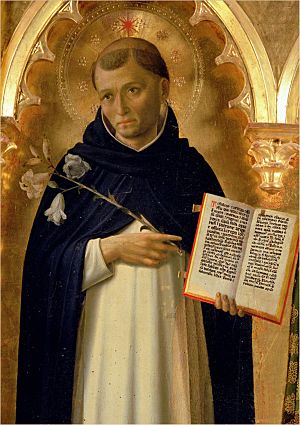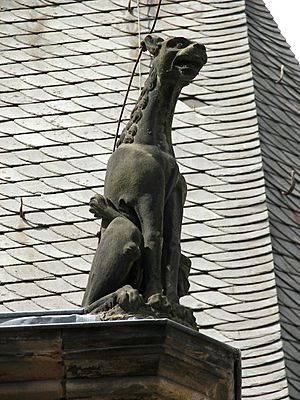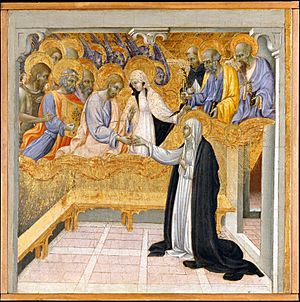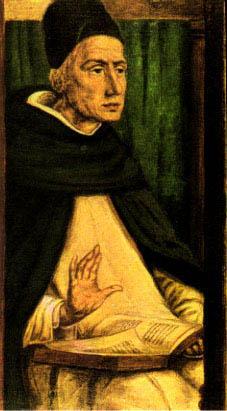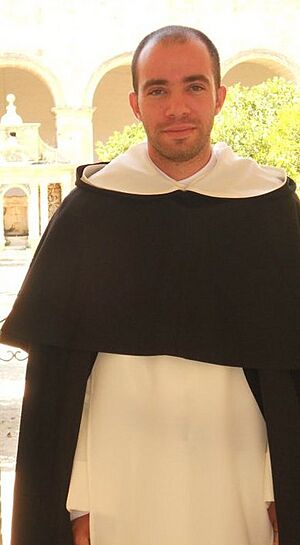Dominican Order facts for kids
|
Ordo Prædicatorum
|
|
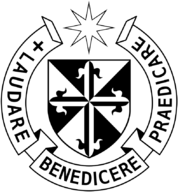
Coat of arms of the order
|
|
| Abbreviation | OP |
|---|---|
| Formation |
|
| Founder | Dominic de Guzmán |
| Founded at |
|
| Headquarters | Convento Santa Sabina, Piazza Pietro d'Illiria 1, Rome, Italy |
|
Membership (2020)
|
5,545 members (includes 4,147 priests) |
|
Master of the Order
|
Fr. Gerard Timoner III, OP |
|
Parent organization
|
Catholic Church |
| Motto: Laudare, benedicere, praedicare ('To praise, to bless, to preach') Principal Patrons: | |
The Order of Preachers (Latin: Ordo Prædicatorum), often called the Dominican Order, is a Catholic religious group. It was started in France by a priest named Dominic de Guzmán. The Pope officially approved the order on December 22, 1216.
Members of this order are called Dominicans. They often use the letters OP after their names. This stands for Ordinis Praedicatorum, which means 'of the Order of Preachers'. The order includes different types of members: friars (brothers), nuns, active sisters, and lay (regular) people.
The Dominicans were founded to preach the gospel (Christian teachings) and to stand against ideas they believed were wrong. Their focus on teaching and learning made them very important in the intellectual life of the Middle Ages. They are known for their smart thinkers and for having many famous theologians (people who study religion) and philosophers. In 2018, there were 5,747 Dominican friars, including 4,299 priests. The leader of the order is called the Master of the Order. As of 2022, this leader is Gerard Timoner III.
Contents
How the Order Started
The Dominican Order began during the Middle Ages. At this time, many religious people started to travel and preach among the public, instead of staying only in monasteries. Two main groups of these traveling friars appeared: the Friars Minor, led by Francis of Assisi, and the Friars Preachers, led by Dominic de Guzmán.
Dominic wanted to create a new kind of religious order. He wanted a group that would combine the strong dedication and education of older monastic orders (like the Benedictines) with more flexibility. This new order would help people in growing cities. The Order of Preachers was formed because there was a need for well-informed preaching. Dominic wanted his new order to be trained to preach in the local languages people spoke.
Dominic taught his followers to value learning and good behavior. He also showed them the importance of simple living and a strong connection to God. The Dominicans were active in preaching, but also spent time in study, prayer, and quiet thinking. They were known for being educated and thoughtful.
Dominic de Guzmán's Early Life
As a young person, Dominic de Guzmán loved studying theology (the study of God and religious beliefs). The Bible was very important to him. During a terrible famine while he was studying, Dominic sold all his books and belongings to help his neighbors. He later became a priest and was appointed to a church chapter in Osma, Spain.
Preaching to the Cathars
In 1203, Dominic traveled with Bishop Diego de Acebo. They went to Denmark for a diplomatic mission. At this time, a group called the Cathars was strong in southern France. The Cathars had different beliefs from the main Catholic Church. They believed that the physical world was evil and only the spirit was good. This idea challenged a core Catholic belief about Jesus.
Dominic felt it was important to try and bring the Cathars back to Catholic beliefs through preaching and teaching. He started near Toulouse. Bishop Diego noticed that Catholic Church representatives often acted very grand and formal, while Cathars lived simple lives. Diego suggested that the Catholic leaders should also live a simpler, more apostolic life to persuade people.
Dominic and Diego worked to convert the Cathars. However, Dominic had limited success in convincing them through persuasion alone. The differences in beliefs were very deep.
Starting the Dominican Convent
In 1206, Dominic started a convent (a community for religious women) in Prouille, near Toulouse. This was for several Cathar women he had helped return to the Catholic faith. This convent became the first home for Dominican nuns, meaning the nuns' order is actually older than the friars'. The monastery in Prouille later became Dominic's main base for his missionary work.
History of the Order
Dominic officially founded the Dominican Order in 1215. He set up a religious community in Toulouse in 1214. This community followed the rule of Saint Augustine and had its own rules for the friars' lives. The main goals of the order were preaching and helping people find salvation.
The Middle Ages
In July 1215, Dominic organized his followers into an official religious group. Their purpose was new for the Catholic Church. These priests were well-trained in religious studies. The Rule of Saint Augustine was chosen for the Dominicans because it allowed them to focus on "the salvation of souls through preaching." This choice meant the Dominican brothers were not monks, but "canons regular." They could serve the public and live together, while also living simply.
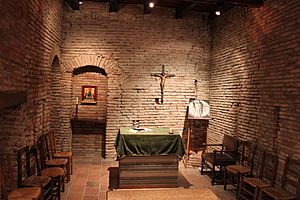
The Order of Preachers was approved by Pope Honorius III in December 1216 and January 1217. On January 21, 1217, the Pope recognized Dominic's followers as an order dedicated to study and allowed them to preach everywhere. Before this, preaching was usually only allowed by local bishops.
Study was a very important part of the order's work. Dominic believed that people could not preach what they did not understand. On August 15, 1217, Dominic sent seven of his followers to Paris, a major university city, to start a priory (a small monastery) focused on study and preaching. This became the order's first major study center. Dominic also started similar centers in other university towns like Bologna and Oxford. The women of the order also started schools for children.
In 1219, Pope Honorius III invited Dominic and his companions to live at a church in Rome called Santa Sabina. In May 1220, the order decided that every new priory should have its own study center. This helped create the Dominican tradition of supporting learning everywhere.
The Dominican friars quickly spread across Europe, including England. By the 13th century, the order reached all parts of Christian society. They fought against ideas they considered wrong and spread Christianity through preaching and books. Their schools became common throughout the church. Famous Dominican thinkers like Albertus Magnus and Thomas Aquinas wrote important works. Some Dominicans even became popes, cardinals, and bishops.
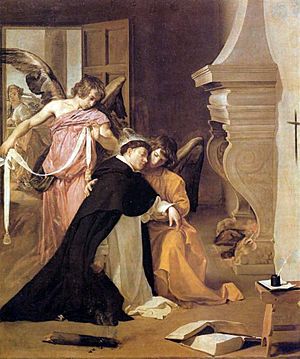
The order's early work against heresy (beliefs different from official church teachings) shaped its future. Many Dominicans continued to fight heresy. For example, Tomás de Torquemada, the first Grand Inquisitor of Spain, was a Dominican. The order was given the job of carrying out the Inquisition by Pope Gregory IX.
The order's growth also led to changes. Some Dominicans focused more on a quiet, spiritual life. This led to a mystical movement, especially in Germany and Italy, with famous figures like Meister Eckhart and Catherine of Siena.

During the Renaissance, the order faced new challenges. They worked against some non-religious ideas of the time. However, many Dominicans also contributed to art, like the famous painters Fra Angelico and Fra Bartolomeo.
Dominican Women
Dominic started houses for women, like the one in Prouille, early on. By 1227, these houses became very popular. By 1358, there were 157 convents for Dominican nuns. However, the number decreased a lot after the Black Death.
Unlike the male Dominican houses, the women's convents were enclosed. The nuns lived a strict monastic life, praying and following all the rules. The friars served as their confessors, priests, and teachers.
Girls could join the Dominican religious life at age 13. Nuns wore a white tunic, a leather belt, a black mantle, and a black veil. They were expected to be silent in places like the chapel, dormitory, and dining hall. Speaking was allowed in a common room, but with strict rules.
Besides sewing and embroidery, the nuns also read and discussed religious books. Some nuns were even fluent in Latin. Learning was very important in their lives.
The English Province
The English Province of the Dominican Order started in 1221. Dominic sent 12 friars to England, led by Gilbert of Fresney. They arrived in Dover on August 5, 1221.
The first Dominican location in England was in Oxford. The friars built a chapel and by 1265, they started building a school. Dominican priories were legally considered schools, so the brothers likely started teaching right away. All Dominican students had to learn grammar, logic, natural philosophy, and theology. Theology was the most important subject.
Dartford Priory was a Dominican convent for women in England. The first nuns there came from a priory in France. The nuns of Dartford were known for their deep learning and strong faith. They lived a very disciplined and simple life.
From the Reformation to the French Revolution
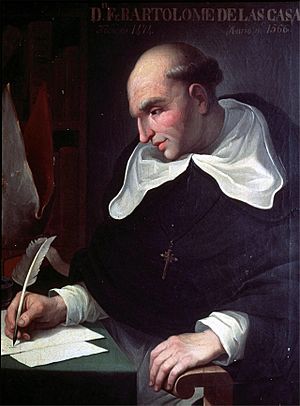
The 16th century brought big changes with the Reformation. The spread of Protestantism caused the Dominicans to lose many of their provinces and convents. However, the discovery of the New World opened new areas for their work.
Bartolomé de Las Casas was a Dominican who lived in the New World. He saw how badly the Spanish colonists treated the Native Americans. He became famous for speaking up for the rights of Native Americans.
Gaspar da Cruz (around 1520–1570) was another Dominican who traveled widely. He was probably the first Christian missionary to preach in Cambodia. He also went to China and later wrote the first European book focused only on China.
In the 18th century, there were many attempts to reform the order, but the number of members decreased. The French Revolution greatly harmed the order in France, and other crises also reduced or destroyed many provinces.
From the 19th Century to Today
In the early 19th century, the number of Dominicans was around 3,500. By 1910, it was about 4,472. As of January 2021, there were 5,753 friars in total, including 4,219 priests.

France played a big role in bringing the order back to life, thanks to the famous speaker Jean-Baptiste Henri Lacordaire (1802–1861). He joined the Dominicans in 1839, and the French province was officially re-established in 1850. This French group helped other provinces grow.
French Dominicans have produced many great preachers. They also founded and run the École Biblique et Archéologique française de Jérusalem in Jerusalem, which is a leading center for studying the Bible. The famous Jerusalem Bible was prepared there.
Many Dominican convents for nuns were forced to close during the Reformation. However, St Ursula's in Augsburg managed to survive and later founded many new houses. In the 17th century, bishops often asked Dominican women's convents to do active work, like teaching girls or helping the sick. In the 19th century, after Napoleon closed many convents, King Louis I of Bavaria allowed women's religious orders to return if they did work useful to the state, like teaching or nursing.
Missions Around the World
In the 13th and 14th centuries, a period of peace called the Pax Mongolica allowed Western missionaries to travel to Asia. Dominican friars were preaching in Russia by 1225. The most famous Dominican traveler was Jordanus de Severac, who went to Persia and then to India in 1321. He wrote a book called Wonders of the East about his travels.
Another Dominican, Riccoldo da Monte di Croce, worked in Syria and Persia. He traveled to Baghdad, where he met other Dominicans and discussed religion with different groups.
By the 1850s, the Dominicans had many followers in the Philippines. They also had strong missions in China and Vietnam, performing thousands of baptisms each year. The Dominicans in the Philippines have been very important in education, founding schools like Colegio de San Juan de Letran.
Different Parts of the Order
The Dominican Order includes friars, nuns, lay Dominicans (also called the Third Order), and priestly groups. Together with religious sisters and associates, they form the Dominican Family.
How the Order is Governed
The highest authority in the Order of Preachers is the General Chapter. This group makes rules for all parts of the Dominican Order and makes sure they are followed. The General Chapter has two parts: the Chapter of Provincials (leaders of different regions) and the Chapter of Definitors (representatives from each region). Both groups have equal power.
The General Chapter elects the Master of the Order. The Master has wide authority over all members and communities. The Master is elected for a nine-year term and is helped by the General Curia.
Nuns
The Dominican nuns were founded by Dominic even before the friars. They live a quiet, contemplative life in enclosed monasteries. They celebrated their 800th anniversary in 2006. Some monasteries earn money by making religious items or baking communion wafers.
Friars
Friars are male members of the order. They include priests and non-ordained members called cooperator brothers. Both priests and cooperators do many different kinds of work, such as preaching, working in parishes, teaching, and social work. Dominican life is based on four main ideas: prayer, study, community, and preaching. Dominicans are known for their strong focus on learning, which helps their preaching. They also like to discuss ideas with scholars. A long period of study is needed before they make their final promises to the order.
Religious Sisters
Women have been part of the Dominican Order from the start. However, active groups of Dominican sisters, as we know them today, mostly developed in the 19th century and later. They came from the Dominican nuns and from groups of laywomen (tertiaries) who lived in their own homes but met regularly to pray and study. A famous example was Catherine of Siena.
In the 17th century, some European Dominican monasteries temporarily stopped being enclosed so they could teach or nurse people in need. In the 19th century, many monasteries were asked to send groups of women to start schools and medical clinics around the world. These groups often became self-governing. As of today, there are 24,600 sisters in 150 Dominican religious groups in 109 countries.
Like the friars, Dominican sisters live by four main values: community life, common prayer, study, and service. Dominic called this way of life "holy preaching." The famous artist Henri Matisse was so impressed by the care he received from Dominican sisters that he helped design their chapel in France.
Priestly Fraternities of St. Dominic
These groups are made up of diocesan priests (priests who work for a local bishop) who are officially connected to the Dominican Order. They follow a special rule of life and try to live a very religious life under the guidance of the Dominican friars. They share in the Dominican spirit and mission, but they remain free to serve their local church under their own bishop.
Dominican Laity (Third Order)
Lay Dominicans are regular people who are part of the order but do not live in convents or monasteries. They follow their own rules, which were last updated in 1987. They have a special way of living their faith and serving God and others. As members of the order, they share in its mission through prayer, study, and preaching, but in their everyday lives.
Pope Pius XII said in 1958 that Lay Dominicans are expected to seek a deeper understanding of God and to live out their Christian beliefs more fully.
Two of the most famous saints among the Lay Dominicans are Catherine of Siena and Rose of Lima. They lived very simple and religious lives in their own homes, but they had a big impact on their societies.
Associates
In the 20th century, groups called Associates were formed. These are Christian men and women – married, single, divorced, or widowed, and even some clergy members – who feel called to share the spirit and mission of the Dominican Order. They do not take religious vows, but they promise to work with the vowed members and share the Dominican mission in their own lives, families, jobs, and communities. They are often connected to a specific work of the Dominican sisters they belong to.
Dominican Spirituality
The Dominican Order is known for its focus on learning and helping others. These qualities set it apart from other religious orders. From the beginning, Dominicans valued both deep study and a close, personal relationship with God.
Humbert of Romans
Humbert of Romans was the Master General of the order from 1254 to 1263. He was a great leader, preacher, and writer. He wanted his friars to be excellent preachers.
Humbert advised young Dominicans not to seek visions or miracles, but to focus on doing good, which leads to salvation. He also told them not to be sad if they didn't feel strong spiritual comfort, because God sometimes withholds these feelings for a reason. He taught that having a good will is what God truly cares about.
Mysticism
Mysticism is the belief that all believers can experience God's love in a very personal way. This can involve feeling very close to God and gaining a direct understanding of Him, which goes beyond just thinking. The goal of mysticism is to become more like Christ and to feel united with God.
Early Dominicans were very interested in mysticism and learning. While some European Dominicans focused on intense, ecstatic experiences of being united with God, English Dominicans focused more on trying to live a moral life like Christ.
Saint Albertus Magnus
Albert the Great was another important Dominican who shaped the order's spirituality. He believed that we can know things about God, but our knowledge is limited. It's easier to say what God is not than what God is.
Albert the Great wrote that wisdom and understanding help strengthen one's faith in God. He believed these were tools God uses to connect with people who are thinking deeply about Him. Love in the soul leads to both an intellectual and an emotional understanding of God. Through deep thought and prayer, things that seemed unchanging can become full of possibility. This kind of thinking helps people know that God exists, even if they can't fully grasp what God is.
Rhineland Mysticism
Mysticism in the Rhineland (a region in Germany) grew during times of difficulty, like political problems and the Black Death. Albertus Magnus's writings greatly influenced German mysticism, which became very strong among groups like the Beguines and women like Hildegard of Bingen.
In Europe, it was often the female Dominicans, such as Catherine of Siena and Mechthild of Magdeburg, who became known for having mystical experiences. Famous male Dominicans linked to mysticism include Henry Suso and Johannes Tauler.
One of Meister Eckhart's main ideas was that people should remember the great honor God has given to the human soul.
English Dominican Mysticism
By 1300, the strong focus on preaching and converting people within the order had lessened a bit. Mysticism, with ideas from Albertus Magnus, became very important to the smartest Dominicans. It became a powerful way for people to change themselves and their understanding of God.
English Dominican mysticism in the late Middle Ages was different from European mysticism. While European Dominicans often focused on intense, ecstatic experiences of being united with God, English Dominicans focused on a key part of their personal relationship with God: trying to imitate Christ's moral life. This was seen as a way to change human nature to be more like God.
This type of mysticism had four parts:
- First, it meant trying to live like Christ morally.
- Second, it connected imitating Christ's life with humanity's role as images of God.
- Third, it focused on a practical spirituality that included loving other people.
- Finally, the main goal was to become truly united with God, either in spirit or in reality.
For English Dominican mystics, the mystical experience wasn't just one moment of knowing God fully. It was a journey of faith that led to a deeper, personal understanding of God. They believed it was possible to live a mystical life without having visions or hearing voices.
Christ is at the center of all mystical experience. English Dominicans wanted to understand Christ fully by imitating his life. English mystics often focused on the moral lessons from events in Christ's life. This led to a deeper understanding of the Bible. The simplest way to imitate Christ was to copy the good actions and attitudes Jesus showed during his time on Earth. This was seen as the most important way to feel and know God.
The English Dominicans focused on the spirit of Christ's life. They didn't expect or seek physical signs like the stigmata. They wanted to create within themselves the kind of environment that allowed Jesus to fulfill his divine mission. At the heart of this was love, which Christ showed for humanity by becoming human. Christ's love shows God's mercy and care for his creation. English Dominican mystics tried to become images of God through this love. This spiritual growth, in turn, led to more love for God and humanity.
Theological Tradition
Since the 13th century, Dominicans have followed a continuous tradition called Thomism. This is a system of religious study based on the writings of Thomas Aquinas. It means that Dominicans have always taught the ideas of Saint Thomas Aquinas in both philosophy and theology.
Devotion to Mary
Showing devotion to the Virgin Mary was another very important part of Dominican spirituality. The Dominicans believed their order was started through the help of Christ's mother. They believed she sent missionaries to help save people's souls. Dominican brothers and sisters who couldn't participate in the main daily prayers would sing the Little Office of the Blessed Virgin Mary each day and honor her.
For centuries, the Holy Rosary has been very important to Dominicans. Pope Pius XI said that "The Rosary of Mary is the principle and foundation on which the very Order of Saint Dominic rests." Stories often say that Saint Dominic himself received the Rosary from the Virgin Mary. Dominicans have been key in spreading the Rosary and teaching about its importance in the Catholic faith.
On January 1, 2008, the Master of the Order declared a year dedicated to the Rosary.
Other Names for the Order
The Dominican Order and its members have been called by several other names:
- In England, Dominican friars are known as Black Friars. This is because of the black cloak they wear over their white religious clothes. They were called "Blackfriars" to tell them apart from "Whitefriars" (Carmelites) or "Greyfriars" (Franciscans).
- In France, Dominicans were called Jacobins. This name came from their main convent in Paris, which was next to the Church of Saint-Jacques.
- Their name "Dominicans" also led to a clever play on words: Domini canes, which means "Hounds of the Lord."
Mottoes
- Laudare, benedicere, praedicare: To praise, to bless, and to preach.
- Veritas: Truth.
- Contemplare et contemplata aliis tradere: To study and to share the results of study (or, to contemplate and to share the fruits of contemplation).
- One in faith, hope, and love.
Famous Members
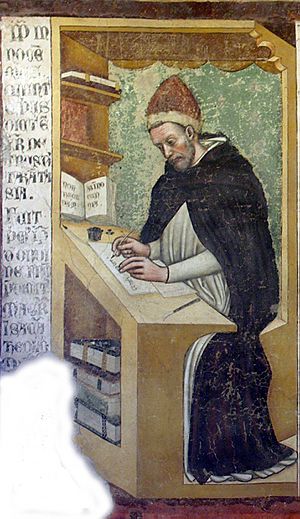
Dominican Popes and Cardinals
Four Dominican friars have become Pope:
- Pope Innocent V (served 1276)
- Pope Benedict XI (served 1303–04)
- Pope Pius V (served 1566–72)
- Pope Benedict XIII (served 1724–30)
The first Dominican cardinal was Hugh of Saint-Cher, chosen in 1244.
As of today, there are five Dominican friars and one member of the priestly fraternity in the College of Cardinals:
- Dominik Duka (born 1943), from the Czech Republic, former Archbishop of Prague.
- Christoph Schönborn (born 1945), from Austria, Archbishop of Vienna.
- Jose Advincula Jr. (born 1952), from the Philippines, Archbishop of Manila.
- Jean-Paul Vesco (born 1962), from France, Archbishop of Algiers.
- Frank Leo (born 1971), from Canada, Archbishop of Toronto (member of the Priestly Fraternity).
- Timothy Radcliffe (born 1945), from Britain, former Master of the Order of Preachers.
Other Notable Dominicans
Many other Dominicans have been famous for different reasons:
- Fra Angelico (1395–1455), a painter.
- Thomas Aquinas (around 1225–1274), a very important religious scholar.
- Bartolomé de las Casas (1484–1566), a Spanish bishop known as the Protector of the Indians for defending Native Americans.
- Meister Eckhart (around 1260-around 1328), a German mystic and preacher.
- Girolamo Savonarola (1452–1498), an Italian preacher who ruled Florence for a time.
- Catherine of Siena (1347–1380), a lay Dominican saint known for her influence.
- Rose of Lima (1586–1617), a lay Dominican saint from Peru.
- Dominique Pire (1910–1969), who received the Nobel Peace Prize.
Educational Institutions
The Dominicans have founded and run many schools and universities around the world, showing their strong commitment to education. Here are some examples:
- Albertus Magnus College, United States
- Aquinas College, United States
- Aquinas Institute of Theology, United States
- Barry University, United States
- Blackfriars Hall, Oxford, United Kingdom
- Colegio de San Juan de Letran, Philippines (founded 1620)
- Dominican University, United States
- Dominican University College, Canada
- Dominican University of California, United States
- Edgewood College, United States
- Ohio Dominican University, United States
- The Pontifical and Royal University of Santo Tomas, Philippines (founded 1611)
- Pontifical University of Saint Thomas Aquinas, Rome, Italy
- Providence College, United States
- Universidad Santo Tomas de Aquino, Dominican Republic (founded 1538, first university in the New World)
See also
 In Spanish: Orden de Predicadores para niños
In Spanish: Orden de Predicadores para niños
- Anglican Order of Preachers
- Dominican Nuns of the Perpetual Rosary
- Dominican Rite
- List of saints of the Dominican Order
- List of sites of the Dominican Order
- Master of the Order of Preachers
- Spanish Inquisition
- Third Order of Saint Dominic


